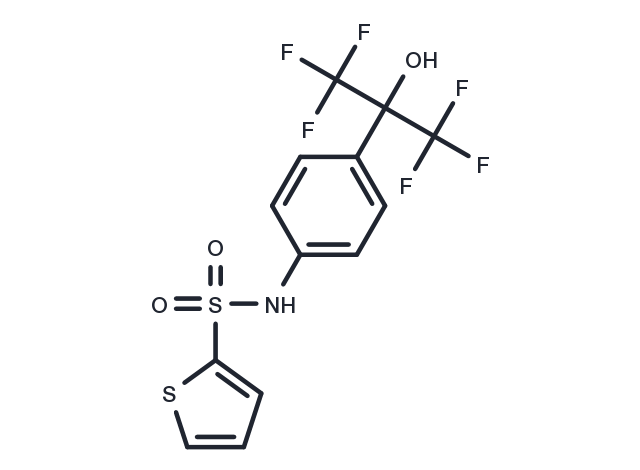Powder: -20°C for 3 years | In solvent: -80°C for 1 year
SR3335 (ML 176) is a selective inverse agonist of RORα, competitively inhibiting the binding of 25-hydroxycholesterol to the ligand binding domain (Ki: 220 nM).

| パッケージサイズ | 在庫状況 | 単価(税別) | |||
|---|---|---|---|---|---|
| サンプルについてお問い合わせ | |||||
| 1 mg | 在庫あり | ¥ 7,500 | |||
| 5 mg | 在庫あり | ¥ 16,500 | |||
| 10 mg | 在庫あり | ¥ 29,500 | |||
| 25 mg | 在庫あり | ¥ 59,500 | |||
| 50 mg | 在庫あり | ¥ 110,000 | |||
| 100 mg | 在庫あり | ¥ 158,500 | |||
| 1 mL * 10 mM (in DMSO) | 在庫あり | ¥ 18,500 | |||
| 説明 | SR3335 (ML 176) is a selective inverse agonist of RORα, competitively inhibiting the binding of 25-hydroxycholesterol to the ligand binding domain (Ki: 220 nM). |
| ターゲット&IC50 | RORα:220 nM(ki) |
| In vitro | KHS101 increased neuronal differentiation of adherently cultured rat NPCs in a dose-dependent fashion (EC50 ~ 1 μM). KHS101-induced neuron formation (40–60% TuJ1+ cells at 1.5–5 μM KHS101) was also observed under neurosphere-forming conditions in secondary neurospheres derived from both the hippocampus and the subventricular zone (SVZ) of adult rats [1]. In HCC cell lines, KHS101 suppressed cell growth and sphere formation as well as the expression of stem cell transcription factors, including Bmi1, c-Myc, and Nanog. Silencing TACC3 may suppress the Wnt/β-catenin and PI3K/AKT signaling pathways, which regulate cancer stem cell-like characteristics [2]. KHS101 exerted cytotoxic effects by disrupting the mitochondrial chaperone heat shock protein family D member 1 (HSPD1). In GBM cells, KHS101 promoted aggregation of proteins regulating mitochondrial integrity and energy metabolism. Mitochondrial bioenergetic capacity and glycolytic activity were selectively impaired in KHS101-treated GBM cells [3]. |
| In vivo | In two intracranial patient-derived xenograft tumor models in mice, systemic administration of KHS101 reduced tumor growth and increased survival without discernible side effects. The doses of 6 mg/kg KHS101 (i.v. and s.c.) resulted in reasonable plasma concentrations (>1.5 μM) with a plasma half-life of 1.1–1.4 h, and relative bioavailability of 69% following s.c. dosing. Most importantly, the distribution of KHS101 to the brain was extensive as demonstrated by a brain-to-plasma AUC(0–3h) ratio of ~8 (dosing: 3 mg/kg KHS101, i.v.) [3]. |
| 細胞研究 | Rat NPCs were derived and cultured as described previously by others. After hippocampal cell isolation, the number of dissociated cells was determined and ~5 × 10^5 cells were plated in 60-mm uncoated plates. After overnight incubation (37 °C, 5% CO2, and 95% humidity), the medium was changed and the cells were expanded and maintained in an undifferentiated state on polyornithine- (10 μg/mL in water) and laminin-coated (5 μg/mL in PBS;) dishes in DMEM/F12 supplemented with N2 and basic fibroblast growth factor (bFGF, 20 ng/mL;). For KHS101 and shRNA-induction experiments, early passage cells (passaged no more than six times after hippocampal isolation) were trypsinized and plated at a density of ~1,000 cells/cm2 into N2 medium (DMEM/F12 supplemented with N2) containing KHS analogs (e.g., KHS101, KHS92, and NP; SI Text) at different concentrations (0.5–5 μM) or DMSO (0.1%), RA (1–2 μM), BDNF (100 ng/mL), and/or BMP4 (50–100 ng/mL) for 4 d [1]. |
| 動物実験 | To investigate the pharmacokinetic properties of KHS101, male Sprague–Dawley rats were administered 3 mg/kg KHS101 i.v. or s.c. One rat was killed per time point at 5 min, 40 min, 1 h, and 3 h after dosing, and samples of blood (100 μL) and whole brains were collected. In a separate study, rats were administered 6 mg/kg KHS101 i.v. or s.c. Five blood samples of 100 μL each were collected serially via a jugular vein catheter at 2 min (i.v. only), 0.5 h (s.c. only), and 1, 3, 7 and 24 h after dosing. Plasma and homogenized whole brain samples were analyzed by liquid chromatography-tandem mass spectrometry (LC-MS/MS). To study neuronal differentiation upon KHS101 administration in vivo, adult Fisher 344 rats (~10 wk old) received s.c. injections of 6 mg/kg KHS101 or vehicle control (5% ethanol in 15% Captisol). All rats received one daily i.p. injection of 200 mg/kg BrdU for 6 consecutive days after the first day. After 14 d, the animals were killed and perfusion fixed, and the brains were removed and subjected to immunohistochemical analysis [1]. |
| 別名 | ML 176 |
| 分子量 | 405.34 |
| 分子式 | C13H9F6NO3S2 |
| CAS No. | 293753-05-6 |
Powder: -20°C for 3 years | In solvent: -80°C for 1 year
Ethanol: 30 mg/mL
DMSO: 50 mg/mL (123.35 mM)
You can also refer to dose conversion for different animals. 詳細
bottom
Please see Inhibitor Handling Instructions for more frequently ask questions. Topics include: how to prepare stock solutions, how to store products, and cautions on cell-based assays & animal experiments, etc.
SR3335 293753-05-6 Metabolism ROR RAR-related orphan receptor ML 176 inhibit Inhibitor SR-3335 ML-176 SR 3335 ML176 inhibitor
